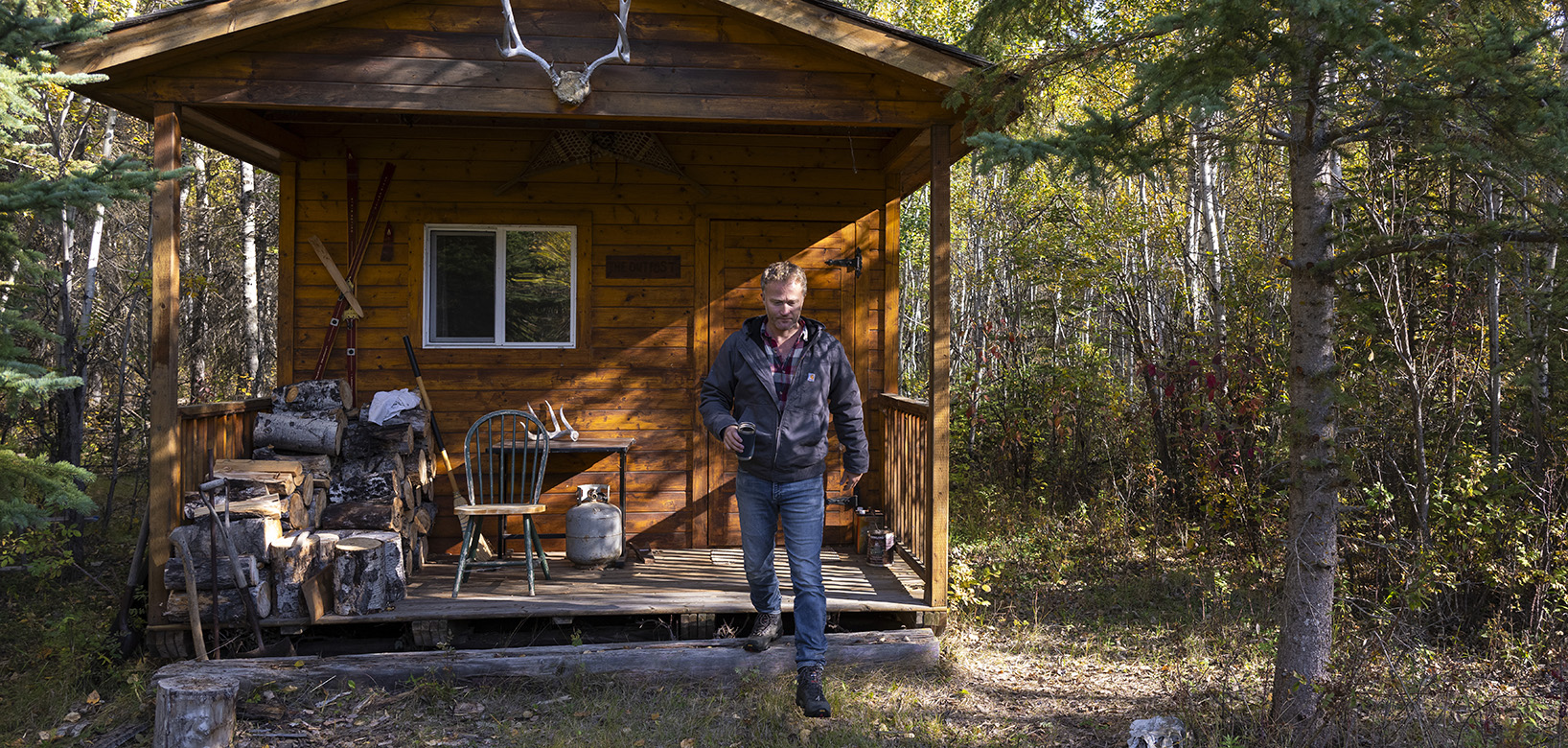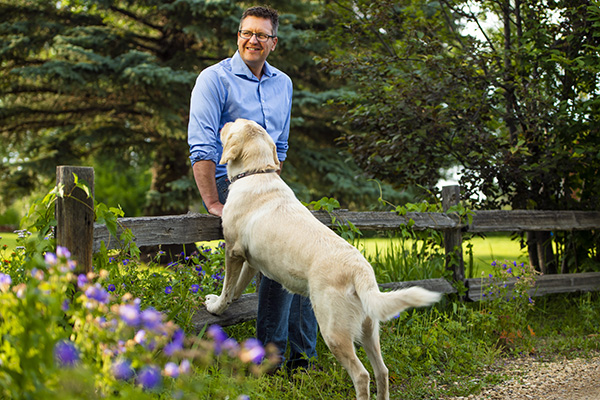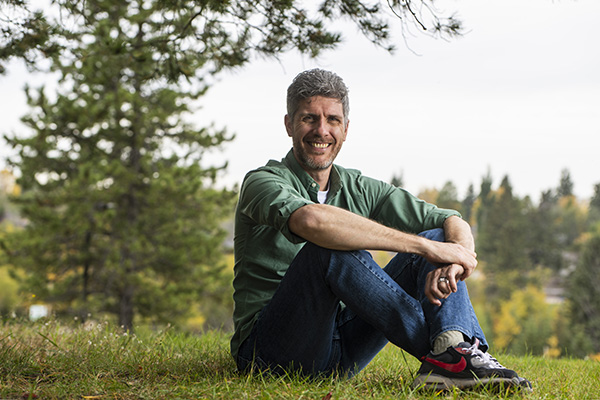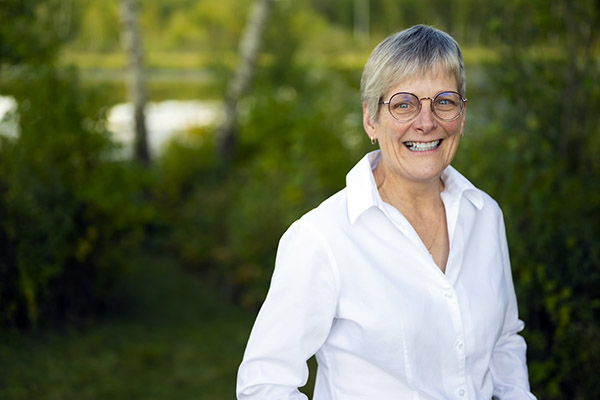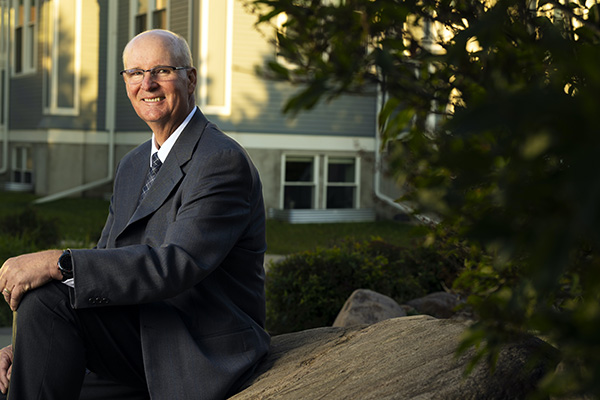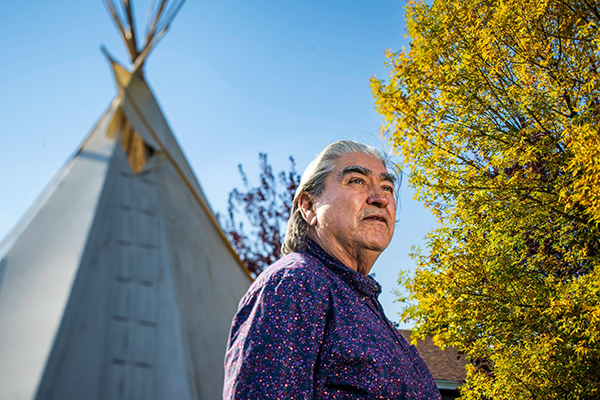Message from the Dean
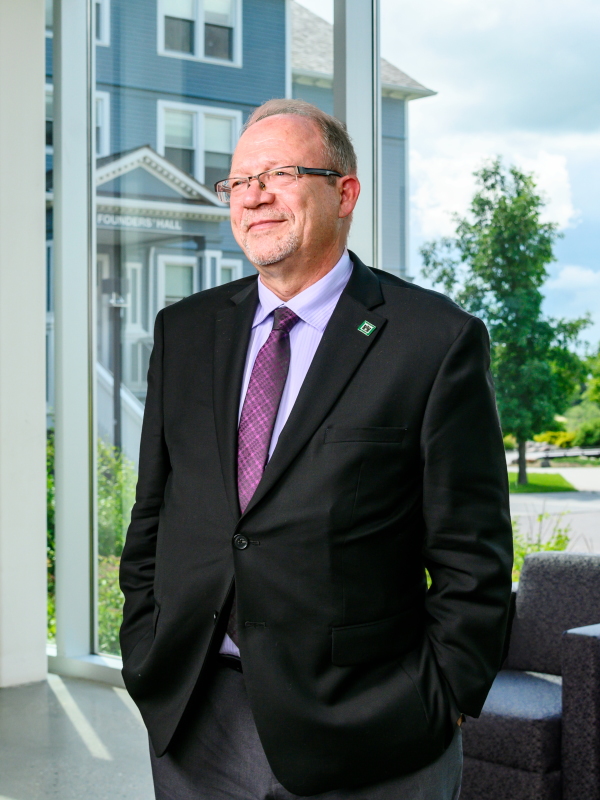
A UNIVERSITY EDUCATION is a precious commodity. The University of Alberta and Augustana Campus have been around for more than 100 years and will continue to educate students for decades to come. But what we teach and the way we teach are changing in response to new developments in education, technology and society. So we keep changing, improving and responding to developments. For instance, we are excited to bring a new bachelor of education program to campus next year as well as three master’s programs in rehabilitation medicine.
Our liberal arts and sciences mission, delivered by our caring and committed faculty and staff, will prepare students for lifelong learning and success. As alumni, you believe in the mission and purpose of universities, too. In this issue you’ll find stories about alumni and researchers who embody that mission and purpose. I’m confident that you’ll enjoy reading about two new faculty colleagues: Clark Banack (rural studies) and Gianluca Vernillo (physical education), both of whom are conducting exciting research and scholarship. Meanwhile, our established faculty members continue to excel in their respective areas, such as criminologist Justin Tetrault’s innovative research on the experiences of incarcerated people, in particular, Indigenous programs in prisons.
The focus of higher education should be to prepare students for changes to come. So we spoke to three alumni about how they made decisions in their careers — whether to change or stay the course. We also spoke to alumnus John Pattison-Williams about his research on wetlands and agriculture, and how his career combines academic rigour and industry-forward research.
In this issue, you will also meet our three 2023 Augustana Alumni Awards recipients. We recognize and celebrate our community members’ achievements and their sustained support of our campus community. Our award recipients (Dee Patriquin, James Mayer and Elder John Crier) exemplify what it means “To Lead and to Serve.”
In this, my final year as Augustana’s dean and executive officer, I think of how quickly time passes. I have found my role at this top Canadian university challenging and rewarding. And besides enjoying my administrative work and the success of our students, faculty, staff and community members, I also have appreciated how Camrose, the surrounding communities and our alumni continue to support Augustana and its students.
Thank you, and please enjoy the stories below.
Demetres P. Tryphonopoulos
Dean and Executive Officer
Augustana Campus
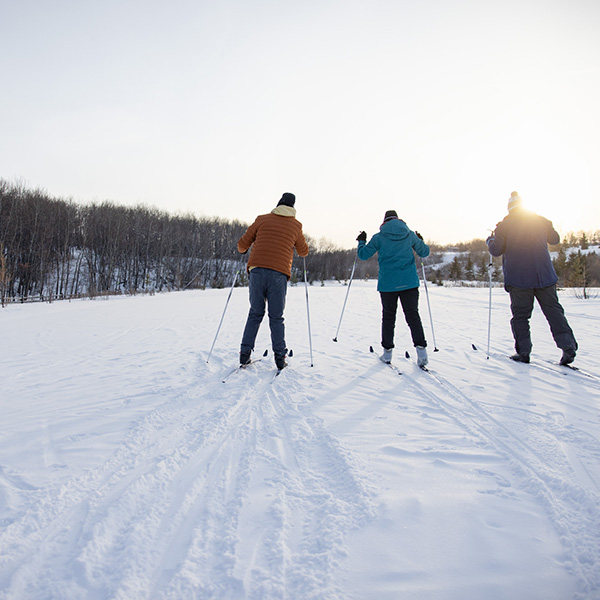
Get Out There
An outdoor adventure is close at hand, whether it’s your first Alberta winter or your 50th
AUGUSTANA LIBRARY IS MORE THAN BOOKS! In partnership with Augustana Campus Recreation, it’s home to the Dr. Garry & Dorothy Gibson Nordic Ski Library, which boasts cross-country ski equipment, skates and snowshoes. Students, staff, faculty and alumni can borrow the equipment for 72-hour loans. The Stoney Creek Valley trails (pictured), with their 16 kilometres of trails maintained by the Camrose Ski Club, are less than a block away from campus. Just pick up your equipment and head outside. Campus Rec also offers learn-to-ski sessions and social ski meet-ups. –LAUREL WARKENTIN
Rehab Med is Back at Augustana
CENTRAL ALBERTANS SEEKING health-care careers will have more opportunities closer to home, thanks to new provincial funding for three rehabilitation medicine programs at Augustana Campus.
The province is providing more than $7.4 million to create 44 seats per year for satellite master’s programs at Augustana in speech-language pathology, occupational therapy and physical therapy, all offered by the Faculty of Rehabilitation Medicine.
“The Augustana community enthusiastically welcomes the return and expansion of these professional programs on our campus,” says Dean Demetres Tryphonopoulos. He says the initiative makes programs accessible to students who want to study and stay in rural Alberta, where there’s a shortage of physical, occupational and speech therapists.
The funding is part of a larger investment by the Alberta government to offer post-secondary programs across the province, prioritizing health care, technology and business. The investment will also allow 40 new seats to be created for other U of A health science programs, including nearly $2.7 million for 22 seats in the BSc in medical laboratory science, $288,480 for six seats in the MSc program in public health and $320,000 for 12 seats in the course-based master’s program in modelling, data and predictions.
–MADISEN GEE, ’21 BA, ’21 CERT(CSL)
Home Arts Network
Regional representation is alive
WHEN ASSOCIATE PROFESSOR ANDREA KORDA went to conferences of art historians in Vancouver, Montreal or Toronto, she saw that Canada’s metropolitan centres had strong networks of art historians, gallery owners, artists, curators and arts professionals (people working in museums, galleries and artist-run centres). At one conference, she found herself huddled with peers Devon Smither from the University of Lethbridge and Karla McManus from the University of Regina, talking about the challenges of Prairie networking amid greater distances and smaller populations. It was the genesis of the Prairie Art Network.
First, they found out who wanted to take part in a network, and that a significant subset were interested in an in-person institute. Second, they set about organizing that institute, an event they called, Art Under the Big Sky: Building a Prairie Art Historians Network and Summer Institute, which was funded by a SSHRC Connection Grant, the Jarislowsky Institute for Studies in Canadian Art and the three respective universities. “We met in June 2023 in Regina,” Korda says.
And there was enthusiasm for the institute. Attendees included 125 art historians, artists, curators, students and arts professionals. “We heard that people want help with fundraising, supporting smaller institutions and cross-institute collaboration,” she says. Especially gratifying was the enthusiastic participation of students who wanted arts careers close to home. “We want to support students and a thriving art scene.” But if you ask Korda to define Prairie art, she won’t. This network, she says, is about the people behind the art.
–MIFI PURVIS, ’93 BA
A Base on Which to Build
Women’s basketball had a great first season with new head coach
Megan Wickstrom, ’14 BKin, ’17 MCoach, grew up playing basketball, like her mom Sarah Wickstrom, ’81 BEd. And like her mom, she played for the Pandas. “I played during my undergrad and graduate degrees,” she says. She built her resumé with the Junior Pandas, as an assistant coach at MacEwan University, and as a strength and conditioning coach. She started her first head coaching gig with the women’s Vikings in 2022-23. “We had a great run, played really well into playoffs and ended up finishing second in the Alberta Colleges Athletic Conference (ACAC). We went to nationals for the second time in program history, and finished tied for fifth.” The team now includes veterans who are “highly motivated to experience similar success and to win our first ACAC gold medal for Augustana,” she says. We asked what advice she’d give to new coaches. –MIFI PURVIS, ’93 BA
USE YOUR PAST
“I worked for several years as a strength trainer in a physio clinic,” Wickstrom says. “It gives me an advantage at a smaller campus. We don’t have a full-time strength and conditioning coach for our athletics teams. I have a good understanding of rest and recovery. I know the physical demands of the sport and the season, and how to periodize training to perform at our best throughout the year.”
USE YOUR PAST
“One of our athletes was a good scorer in practice, but during games nothing would go in the hoop. So we spent time talking to change her thoughts and mindset during games,” she says. “Athletes can get to that zone of, ‘I missed again, when am I going to score?’ I knew she was a good player. Midway through the season, the Saran wrap came off the hoop and she started scoring consistently.”
DO WHAT YOU LOVE
“Maybe long term, I’d like to be head coach of a U Sports school, but right now I’m so happy where I am,” she says. “I’m really excited to do this job. People are gonna pay me to hang out in a gym with a bunch of young people that love to play basketball! That’s really awesome.”
Missing and Murdered
Researcher traces violence against Indigenous women through the centuries
DURING A RECENT lunch-and-learn event, researcher Willow White, ’15 MA, explained how colonialism has contributed to the ongoing crisis of missing and murdered Indigenous women, girls and two-spirit people (MMIWG2S). She is a member of the Métis Nation of Alberta and an English literature and Indigenous studies professor at Augustana Campus.
“Indigenous women continue to experience the greatest amount of violence of any identity group in this country,” White says. “MMIWG2S is not a modern phenomenon. It is a tradition of colonialism in North America.”
She explains this violence started more than 400 years ago, when a Pamunkey and Mattaponi teenager called Pocahontas was kidnapped by English settlers and taken to England. Centuries later, legislation like Canada’s 1876 Indian Act made the problem systemic.
“The Indian Act devalued Indigenous women and sanctioned violence against them,” says White. One consequence of the act was that Indigenous women lost their status and treaty rights if they married non-status or non-Indigenous people. Without status, the women, their children and their grandchildren didn’t have the right to live on reserve, isolating them from community support and making them more susceptible to violence.
In 2016, Canada launched a national inquiry into the MMIWG2S crisis, partly in response to outrage over the 2014 death of Manitoba teenager Tina Fontaine. But White says many Indigenous people and others say the inquiry has been insufficient. “Until Canada is ready to truly acknowledge its colonial history, to tell and teach the truth and seek justice alongside Indigenous Peoples, the violence is unlikely to stop.”
–SANDRINE CAMMINGA
From the Start
Students develop critical learning and career skills from their first day with courses that ready them for success
Carly Rombs, ’23 BA, is among the first cohort of students to graduate with Augustana’s four mandatory “core courses” under her belt.
According to science professor Brian Rempel, ’03 BSc(Hons), who helped develop and teach the curriculum, the core courses teach skills employers value: critical thinking, communication, collaboration and research skills. Students like Rombs gain experience working on multi-faceted problems within a team.
Rombs says the core courses enhanced her academic and personal skills. In her application for graduate studies, she had to account for her teamwork abilities. “I realized I had done this my whole undergrad university career,” she says. “I had so many valuable experiences that helped me get where I am today.”
The core courses build progressively. The first-year seminar introduces students to critical thinking and academic skills. It encourages students to explore topics from multiple perspectives. The second-year core course focuses on teamwork and collaborative projects. In third year, students match with community groups to tackle real-world challenges. Finally, fourth year is dedicated to solving aspects of complex, real-world problems, coalescing what students have learned in the previous courses.
Rombs and her team chose to address the problem of isolation and loneliness, designing a fictional social event that brought people together in a friendly competition, in the manner of the TV show, The Amazing Race.
The core courses also teach business communications, project management, budget management and networking. Students learn to work with minimal supervision to become conscientious colleagues and citizens.
Rombs is prepared for future challenges, she says. “I’ve developed professionalism and learned skills that give me the opportunities to make the world a better place.”
–BEV BETKOWSKI
Meet the Teachers
Augustana is home to researchers who work across the university with surprising areas of expertise.
PHOTOS BY JOHN ULAN
Clark Banack
Assistant Professor, Rural Studies; Director, Alberta Centre for Sustainable Rural Communities (ACSRC)
CLARK BANACK HAS taught political science at Augustana since 2017, but his appointment as assistant professor is new. His research focuses on rural studies, Canadian politics, and religion and politics. He thinks a lot about sustainability.
The nature of agriculture has changed, Banack says, and with it, rural communities. “There’s been a consolidation,” he says. “The size of farms is growing exponentially, which means there are far fewer farm families living in rural areas. In addition, government investment in
rural communities has been in decline across Canada for decades.” He says the industrialization of agriculture and the globalization of agrifood systems have reshaped rural communities.
Under his directorship since 2021, the ACSRC is a U of A initiative focused on fusing research and local outreach. The goal is to improve the sustainability of rural communities by connecting U of A resources with rural organizations, researchers, students and policymakers to create the needed changes.
At ACSRC, Banack hosted a large conference in the fall. Speakers included rural entrepreneurs, co-operative developers and academics to show how the co-operative
model can drive sustainable rural economic development. A rural Albertan book author,
he’s working on his next writing project.–ROBBIE JEFFREY, ’12 BA
Gianluca Vernillo
Assistant Professor, Physical Education
A LONG-DISTANCE RUNNER, Gianluca Vernillo comes from the University of Milan. His research focuses on neuromuscular fatigue, high-level sport performance and endurance. “I want to understand the limits of our capacity during prolonged exercise, like ultra-marathons,” he says. “I’m interested in the body’s physiological and biomechanical adaptations, how neuromuscular fatigue influences exercise and performance.”
He has seen how fatigue affects athletes, working with elite Kenyan marathon runners and the Italian snowboarding team, preparing them for the Olympics. But elite athletes aren’t his only focus. He’s teaching a course on exercise in special populations, such as people with disabilities. “Exercise is also medicine,” he explains. “Evidence shows that physical activity reduces the risk, prevalence and severity of chronic diseases, decreasing the risk of mortality from all causes."
In addition to running, Vernillo is reading Don Quixote, and likes to listen to music, “as long as it is rock and roll.” And what does he wish people understood about exercise? “I already spoiled the answer! I wish everyone understood that, if we’re able to move, we can exercise and exercise is medicine.” –MIFI PURVIS, ’93 BA
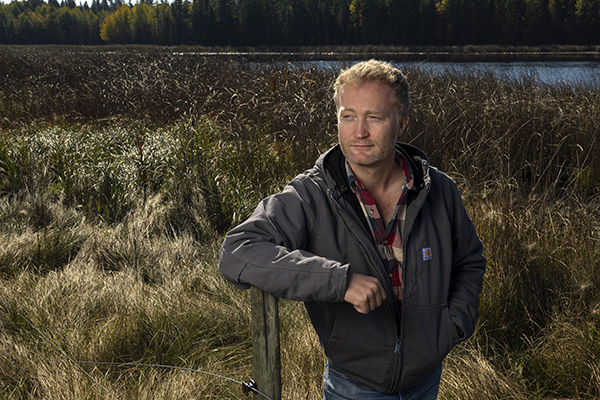
A BETTER BALANCE
In an agricultural setting, managing wetlands can get murky. John Pattison-Williams, ’06 BSc, ’09 MSc, helps farmers assess the value and the challenge.

VOICES RARELY HEARD
Cultural programming for Indigenous people in prison is controversial. Some say it helps incarcerated people grow and heal. Others say prisons only perpetuate colonial values. Researcher Justin Tetrault and his team wanted to hear what the experts had to say. So they asked them.
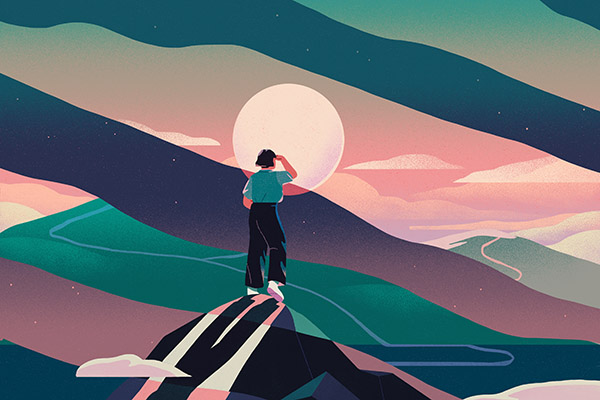
SHOULD I STAY OR SHOULD I GO?
Some life decisions are easy. Sometimes you labour over them. Meet three alumni who’ve made big changes.
Milk and Cookies
Need we say more?
THERE ARE PLENTY OF GOOD REASON TO STUDY AT AUGUSTANA, but the non‑stop chocolate milk is the cherry on top. The sweet stuff has been on tap in the cafeteria since around 1989, fuelling countless study sessions, post-workout recoveries and late-night cravings. It’s been the perfect pairing for Augustana’s famous cookies — which can be found in the cafeteria and at many student and alumni events — and has even helped recruiters to pique the interest of prospective pupils. But that wasn’t always the case. Before chocolate milk was bottomless, students were limited to one glass of plain milk per meal — a rule strictly enforced by cafeteria monitors of the day. Now that the floodgates have opened, it may be the sweetest reason to study on campus. –LISA SZABO, ’16 BA
PHOTOS BY JOHN ULAN
And the Award Goes To...
Every year, Augustana celebrates three outstanding people who make our campus a better place. Meet the 2023 Alumni Award recipients who continue to enrich our community with their volunteer work, mentorship and support.
BY JORDAN WHITEHOUSE | PHOTOS BY JOHN ULAN
ALUMNI CITATION AWARD: Dee Patriquin, ’87 BSc(Spec), ’91 MSc, ’14 PhD
Collaboration has been at the core of her work as a volunteer, mentor and environmental scientist
DEE PATRIQUIN KNOWS A THING or two about how to work with others — especially when it comes to solving big environmental problems. It’s one of the reasons she is this year’s recipient of the Alumni Citation Award.
For over 30 years, the environmental scientist and consultant has collaborated with people from diverse disciplines to find answers to some of the big environmental challenges facing our society. Whether in her current role as district environmental manager with Flatiron Constructors Canada or in past projects involving government and industry partners, Patriquin has had a similar goal: Getting people to work together — some of whom might have vastly different views about how things should unfold.
It’s a skill she has put to good use at Augustana both in and out of the classroom. As a professor, mentor and volunteer with initiatives like the Beaver Hills Biosphere, collaboration has been her North Star. She says the biggest challenge in fostering co-operation between people with different viewpoints is establishing trust between them. “You have to create a setting that allows them to talk about the problem from all those different perspectives and ask the questions that come up.”
She stresses that no single discipline has the answer, but when we listen to one another, we can find our way through the woods. “Building the realization that everybody has a role to play in solving these complex environmental problems is really critical.”
LOIS ASPENES AWARD: James Mayer, ’83 BCom
The support James Mayer received as a student has driven him to give back to Augustana for nearly 50 years
IT'S BEEN 44 YEARS SINCE JAMES MAYER SIRT SET FOOT ON THE CAMPUS of Camrose Lutheran College — now Augustana Campus — but he can still remember the feeling of butterflies in his stomach as he lined up at the registrar’s office. The small-town, 18-year-old kid from Camrose was in a completely new environment. “I was so intimidated,” he remembers.
He quickly learned, however, that one of the advantages of attending a small school like Augustana is that people are more than willing to help. It was a lesson that Mayer would often think about as he moved on to North Campus to complete his degree and later join the family business in Camrose as an insurance broker. It was a lesson that made him want to give back to students, too.
His many contributions to the life of the campus make him this year’s Lois Aspenes Award recipient. In the past four decades, Mayer has been a constant supporter of Augustana, volunteering his time and money to everything from establishing student scholarships to off-setting the cost of acquiring scientific and athletic equipment. Mayer has also been an avid proponent and board member of the Battle River Community Foundation, which has also supported Augustana in various ways through the years.
He says it’s Augustana’s support and involvement in the community that has made him want to stay involved all these years later.
“Augustana is such a jewel, and I am so fortunate to be able to give back.”
DISTINGUISHED ALUMNI AWARD: Elder John Crier, ’99 BA
Elder Crier’s land-based teachings and leadership have affected the Augustana community and far beyond
ASK ELDER JOHN CRIER WHAT HE remembers from his studies at Augustana, and he’ll likely begin with the friendly atmosphere and down-to-earth instructors. But what also sticks with him are the memories of hiking, canoeing and exploring he did as part of his degree, which concentrated on Indigenous studies.
“We were out on the land, looking at the features, the topography,” he says. “I went on to use a lot of that in the land‑based teachings I led.”
The member of the Samson Cree Nation has retired from his day job — he spent 12 years as an elder at the Pê Sâkâstêw Correctional Centre and 11 years on the faculty of Maskwacis Cultural College — but continues his land-based teaching at the U of A and in cultural programs in and around Maskwacîs, Alta. His community work and contributions to Augustana are some of the many reasons he is this year’s Distinguished Alumni Award recipient. From developing a healing retreat centre to mentoring youth and adults alike, Elder Crier has used long-established teachings and traditions to help empower people and heal trauma. At Augustana his support of Indigenous programming, including providing guidance for round dances and leading ceremony for over a decade, have enriched the student experience and brought his love of land-based and traditional approaches full circle.
It’s something Elder Crier says is needed now more than ever. “The way the world is going, we’re creating a toxic environment, and we need to change that,” he says. “We need to reconsider how we create the relationship with the land.”

HOW TO TRAIN LIKE AN OILER
A former Vikings athlete shares pro tips from the NHL
By Lewis Kelly
When Joel Jackson, ’11 BSc, ’15 MSc, was growing up in Snow Lake, Man., he dreamed of a career in the NHL. In 2021, 10 years after graduating from Augustana, he finally joined the Oilers — though not in the way he first imagined. Jackson is a strength and conditioning coach who helps players get the most out of their bodies. Here are three of his tips for working out.
USE THE RIGHT DATA
Jackson uses many high-tech exercise tools to help professional athletes get build muscle. It collects data.
“My favourite is Catapult,” he says. “It allows you to quantify the volume and intensity of the work the players do on the ice through a number of different metrics.”
The players wear the tool on their shoulder pads during practice, and over time, the data builds a detailed portrait of a player’s skating ability. If a player gets injured, the metrics serve as a baseline to determine when they’re ready to play again.
While an amateur doesn’t need Catapult-level stats, data can still come in handy. Running apps, GPS watches or a paper workout log can help you track your training — both to establish a touchstone in case of injury, or to chart your progress.
KEEP IT FRESH AND FUN
One of the most powerful benefits of the cutting-edge tech Jackson uses in his job, he says, is also the simplest: novelty.
Like the rest of us, professional athletes can get bored of routine. Swapping out the squat cage for a 1080 Quantum smart pulley system can be a welcome change.
“It’s good for players to be exposed to new tools,” he says. “It keeps it fresh and keeps them excited.”
The same goes for nonprofessionals. Introduce a little variety to your workout routine by changing up your running route, trying a new Peloton instructor or lifting at a different gym.
DON'T SKIP STRENGTH
While Jackson’s strength and conditioning work with the Oilers can boost the performance of players on the ice, its main benefit is for injury prevention and rehabilitation. This is just as true for the general population.
“As people age, one of the biggest causes of injury is falls,” says Jackson. “When you lose your muscular power, you can’t react as well to tripping or losing your footing. If you have more muscular power, there’s a much better chance that things like that won’t happen.
“Resistance training should be your number one injury prevention tool.”
CLASS NOTES
We’d love to hear what you’re doing! Tell us about your new job, your latest volunteer activities, your recent vacation or your new pet. Celebrate a personal accomplishment or share your favourite campus memory. Submit your class note. Notes will be edited for clarity, length and style.
COMPILED BY MADISEN GEE, ’21 BA, ’21 CERT(CSL)
1970s
’71 Joanne Maynard (Hegge) was inducted in June into the Pioneer Women exhibit at the Millet and District Museum for being a dedicated volunteer in the community. She works with several organizations, including Millet in Bloom and the Arts and Crafts Guild, and is the president of the Millet Seniors Club. Maynard was a nurse at the Wetaskiwin Hospital for more than 30 years before retiring in 2016. These days, she enjoys quilting and spending time with her two daughters and two granddaughters.
’76 Brian Nelson is living with his wife on a small farm east of Camrose, where he is working towards his life goal “of becoming an old hippie.” They grow and raise their own food and heat their farm home using solar panels and firewood harvested from the land. Nelson has held many jobs over the years, including with the Camrose Association for Community Living, where he worked with people living with developmental disabilities. He is passionate about food security in the community and helps run a weekly free community supper. Nelson has a long history of volunteering and is on the board of directors for Sahakarini, a charity that funds community development projects around the world. He is also active with the Camrose United Church as chair of the social concerns committee. He is enjoying learning more about his Métis culture and history with help from the Métis Nation of Alberta.
’76 Dorothy Ritz (Schmidt) retired in 2019 from MacEwan University as director of careers and experience. In the same year, her husband, Randy, retired from Concordia University in Edmonton where he was chair of the Drama Department. The couple has three children: Talia, who teaches kindergarten and is completing her PhD in education; Eli, who works in communications with Service Alberta; and Duran, a musician who was nominated (with the band Rare Americans) at the 2023 Juno Awards.
’77 Carol Breitkreutz (Yamabe) moved to Montreal in April 2019 after retiring from a 28-year teaching career and five years as a school health promotion facilitator with Alberta Health Services. She is happy to be living in an apartment with her spouse, Dale, and cockapoo,
Bowi. They live in the same building as their daughter, Sara Breitkreutz, ’07 BA, and her family, so Carol gets to be a daily part of her grandchildren’s lives. Carol and Dale’s son, Dylan Breitkreutz, ’12 BSc, lives and works in Toronto, close enough to visit. Carol spends her leisure time studying French, solving word puzzles, reading, sewing and sashiko stitching. She enjoys the diverse culture and vibrancy of their Mile End neighbourhood.
’79 Gordon Jensen retired from his position of academic dean and the William Hordern Chair of Theology at the Lutheran Theological Seminary in Saskatoon, where he taught for more than 20 years. He is the author of two books, The Wittenberg Concord: Creating Space for Dialogue (2018) and Experiencing Gospel: The History and Creativity of Martin Luther’s 1534 Bible Project (2023). He is a proud father and grandfather, with two sons and one granddaughter. He and his wife are celebrating 44 years of marriage this year.
1980s
’82 Barbara Bickel recently published a new book, Art-Care Practices for Restoring the Communal: Education, Co‑Inquiry and Healing, which outlines ways to help people use art to connect to themselves and their communities. Bickel co‑wrote the book with R. Michael Fisher.
’86 Mark Radke has been appointed deputy minister of justice and deputy attorney general for the Yukon government.
1990s
’94 Sandeep K. Dhir, BA, was named among Canada’s leading litigators for the 11th straight year in the Benchmark Litigation annual ranking. Dhir is active in the community and has served on boards for the Edmonton Inner City Housing Society, the Edmonton Food Bank and the Theatre Network. He has been co-chair of the South Asian Bar Association’s North American Litigation section since January 2022. In 2016 he was appointed Queen’s Counsel (now King’s Counsel) in recognition of his excellence as a lawyer and contributions to the community.
’97 Deena Hinshaw, BSc, received a Distinguished Alumni Award from the University of Alberta for her work as chief medical officer of health during the first two years of the COVID-19 pandemic.
’98 Shannon Mah (Stang); Tanin Behnke (Cooper), ’00 BA; Nikki Wakulchyk (Harmon), ’00 BA; Allyson Bendfeld, ’01 BA; Carley Flaws (Humber), ’01 BA; Jennifer Gee (Dewey), ’01 BSc; Trisha Keetch, ’01 BA; Alexis Sikora (Redlich), ’01 BSc(Spec); and Jenelle Plasko, ’02 BSc, met 25 years ago at Augustana and began a lifelong friendship they call the Augustana Sisterhood. The women have supported each other through life’s ups and downs, including weddings, births of children, summer celebrations and their annual Santa photo get‑togethers.
2000s
’04 Myranda Bolstad, BA, completed a master’s degree in creative writing at the University of Edinburgh in 2005. She works as a communications professional for the Government of Canada, has recently started editing books and in June of this year published her first children’s book, If The Northern Lights Could Speak, with her longtime best friend and fellow northerner, Sarah Kalnay-Watson. The book is a celebration of the beauty of the Northwest Territories and features the whimsical illustrations of Yellowknife artist, Kaylem Loomis. “We wrote the first draft nearly two decades ago on a Boston Pizza napkin. Sarah and I eventually had to rewrite it, because napkins make for terrible record-keeping,” Bolstad writes. “But ultimately, it led to this little love letter to the North, of which we are incredibly proud.”
’08 Matthew Hebert, BA, has wrapped up four years on the Alumni Council and is working as an assistant deputy minister for the Alberta government.
2010s
’10 Danielle Fostey, BA, and her husband welcomed their first child, Noah, in July 2022. “Since then, I have been on the steepest learning curve I could imagine. Did you know babies can pee while you are already changing their diapers? He turns one in a month and I am already trying to convince him to go to Augustana. Seventeen more years to go!”
’10 Paul Gauthier, BA, and Kendra Gauthier, ’11 BA, are travelling the Pan‑American Highway. They began their trip south from Tuktoyaktuk, N.W.T. in August 2022, and by May, the pair had travelled 43,611 kilometres to Yaviza, Panama, which is the end of the northern part of the road. Their goal is to reach Tierra del Fuego, an archipelago off the southernmost tip of the South American mainland. You can follow their adventures on Instagram, @gogogauthiers.
’11 Gordon Naylor, BSc, became a University of Alberta senator in July. Naylor is the assistant principal at Maskwacîs Cree High School and sits on Augustana’s Indigenous Engagement Collective.
’13 Mariah St. Germain represented Augustana on the 2022-23 Indigenous Alumni Task Force. She moved to the Montreal area with her husband where she is the co-ordinator of Indigenous student success at Concordia University.
’14 Annette Klevgaard is celebrating the publication of her poetry collection, The Wind and The Sky and everything else, which explores our connection and disconnection to the Earth, ourselves and each other. Most of the poems were written while Klevgaard “traversed the plains, foothills and Rocky Mountains, sleeping in a yellow tent beneath the stars and rediscovering wonder and awe.” The entire process, including editing, graphic design and printing, was completed with the support of Edmonton-based artisans and businesses, reflecting her commitment to supporting small businesses. Since its release last year, Klevgaard’s collection, which she published under the name Annette Irene, has been featured in more than a dozen independent stores and is available online through Alpine Book Peddlers.
’15 Larissa Lindmark (Hepp), BMgt, graduated with a master’s of public administration from the University of Victoria in 2022 and has been working for municipalities in rural Alberta for the past eight years.
’15 Louise Omeasoo, BA, and Sarah Skinner, ’10 BA, participated in a panel event “Conversations on Water,” featuring poet and activist Rita Wong. The events explored personal and community relationships with water and included a poetry reading by Wong.
’16 Tonya Simpson, BSc, teaches forensic anthropology on North Campus. She also works with the RCMP Missing Persons Unit and consults with police agencies to assist in identifying human remains. Simpson published a children’s book in May 2023, Forever Our Home / kâkikê kîkinaw, described as a “lullaby of reconciliation and reclamation, celebrating the ancestral relationship between Indigenous children and the land.”
’18 Helaynea Croke (Moore), BSc, is proud to share that she graduated recently with a master’s degree in adult education from St. Francis Xavier University in Nova Scotia. She writes that her undergraduate years at Augustana equipped her with strong foundational skills and the confidence to pursue lifelong learning. “It is the time that I spent at Augustana and the relationships I forged that led me to this success, and I am forever grateful,” she says. “Life may not always lead you where you think you’re meant to go, but it will always lead you where you’re meant to be.”
’18 Carson Roche, BA, is an events manager with Aboriginal Sports Circle Northwest Territories and was the head organizer for the inaugural 2022 Indigenous Summer Games, in which more than 140 athletes competed in traditional games such as Dene wrestling and pole pushing. Roche led Team Northwest Territories in the 2023 North American Indigenous Games in Halifax, N.S. in July as its chef de mission. Outside of work, he is an avid traveller and recently spent a month in Japan.
’19 Hannan Said Mohamud, BA, graduated from the University of Ottawa with a degree in English common law earlier this year and was an elected member of the Board of Governors in her final academic year. Mohamud also received a Top 30 Under 30 award from the Alberta Council for Global Cooperation for her work promoting peaceful and equitable societies in 2021. She is now articling for prominent criminal lawyer Alan Gold in Toronto.
2020s
’21 Kylie Peake, BSc, completed a summer internship in northern Alberta through the Engage North program, where she worked with Beaver First Nation on a variety of community projects. She has also worked as a phlebotomist at Canadian Blood Services and recently finished her first year of medical school at the University of British Columbia’s Northern Medical program. Sports play a large role in Peake’s life — she coaches basketball, plays soccer and is now enjoying the beautiful running trails in Prince George, B.C. “I am very grateful for the amazing professors, mentors, classmates and support staff at Augustana who each played a unique and important role in my education and personal development.”
’23 Jessica Leeson, BA, graduated this spring and spent the summer working with Alberta Wildfire as a wildfire crew leader. She recently moved to Idaho, where she is attending law school.
’23 Shelby Paulgaard, BA, ’23 Cert(Writing), began the master of media in journalism and communications program at Western University in London, Ont. During her time at Augustana, she worked with Stephanie Oliver to curate the visual exhibition of poetry, immersed, by Rita Wong.
Class Memories
Do you have a favourite memory from your time at Camrose Lutheran College, Augustana University College or Augustana Campus? Let us know at augalum@ualberta.ca!
COMPILED BY MADISEN GEE, ’21 BA, ’21 CERT(CSL)
Creative Teaching Makes for Lifelong Learning
I HAVE VERY FOND MEMORIES of my two years at Augustana. I barely passed high school and was so glad to leave all learning institutions. But after a year of really rotten jobs, I realized I was on a path that would not lead to much life satisfaction for me. So I decided to try a year at college.
During my first year at Augustana, I was inspired by the high quality of the professors and the exciting learning environment I found. To take the time to learn, study, discuss and immerse myself in a world of ideas was such a pleasure.
I particularly remember an English class with professor Ed Friesen. We were studying The Canterbury Tales, and were challenged to come up with a different way to examine the tales other than using printed words. I have always been a hands-on sort of guy, so I decided to build a multimedia presentation on various parts of the tales. Please keep in mind this was way back in the dark ages before computers (gasp), so there was no PowerPoint. I sketched 16 pictures on thin parchment paper and constructed four wire cubes to hold the sketches. I attached the cubes to a metal framework that used gears and a small battery‑operated motor from a toy car to rotate the whole mechanism as well as each cube independently. As each cube rotated, a light came on in the center, illuminating one of the parchment scenes. The whole thing was synchronized and moved in time with a cassette tape of selected readings and medieval music.
I know Professor Friesen was surprised when I walked into the class with the contraption, but he was very patient with me as I set it up. At the end all he said was “Well, that was interesting.” I absolutely loved the way he opened up new ways of exploring English, encouraged experiential learning and recognized that many students learn in many ways other than just through printed words. That was a defining moment in my life. Instead of just reading the words, I examined the text for the essential meaning and tried to illustrate that essence in art, music, spoken word and print — all in an experiential manner. From dreading school, I went to absolutely loving learning. Those two years at Augustana changed my life. I have been a lifelong learner ever since.
–’76 BRIAN NELSON
Finding Fun
My favourite memories from Augustana include spending time in wahkohtowin Lodge, playing recreational sports, attending basketball games, faculty follies and making memories with friends. My favourite class was chemistry with James Kariuki.
I loved my time at Augustana and I think being on a smaller campus helped me to be successful. I felt safe as an Indigenous student on campus, and my liberal arts education has made me a well-rounded veterinarian. I greatly valued the opportunity to take drama, Indigenous studies, history and sociology while still obtaining my science prerequisites.
–’17 DAYLE POITRAS-OSTER
Two Degrees, One Diverse Education
MY TIME AT THE U OF A STARTED with a bachelor’s in psychology from Augustana and finished with a master’s in speech-language pathology at North Campus. I will always be thankful for my time spent at the U of A for giving me so many wonderful opportunities, such as going to India, getting to present research in Ireland and Quebec while working as a research assistant, so many interesting learning experiences in labs and during in-house clinical placements, and friendships that have lasted for many years.
–’18 HAILEY SMITH, BA, ’18 CERT(COMMMENTHEALTH)
The Augustana Experience
ALTHOUGH THE PAST FOUR YEARS have been anything but normal, I am so grateful to have had the advantage of the “Augustana Experience” along the way. From taking a first-year class about beer brewing to volunteering all over Camrose for Community-Service Learning experience, I have learned so much about myself and what I want to pursue after my time here.
I have made lifelong friends and have had the privilege of working with exceptional mentors who went above and beyond to help me excel and find my path. Working as a research assistant and the editor-in-chief of The Dagligtale, Augustana’s student paper, have given me vital experience in journalism and communications, and these experiences have pushed me to pursue my passion for writing and lifelong learning. I am so excited to take my experiences and all of the knowledge I’ve gained from Augustana with me, and I can’t wait to find out where they will take me next!
–’23 SHELBY PAULGAARD, BA, ’23 CERT(WRITING)
In Memoriam
Circle magazine notes with sorrow the passing of the following Augustana alumni, based on information we have received between January 2023 and August 2023.
- ’48 Beatrice Ada Kvemshagen
in April 2023 - ’48 Leif Gordon Stolee, ’52 BA, ’54 BEd, ’69 MA, in July 2023
- ’53 Inez Margaret "Peggy" Mollerup (Broughton), ’56 Dip(Nu), in January 2023
- ’58 Otto LaVerne Streberg in January 2023
- ’62 Elaine Ruth Martin (Elford) in April 2023
- ’65 Rodney Edwin Soholt, ’68 BPE, ’71 BEd, ’73 MEd, in June 2023
- ’67 David Charles Ayre, ’85 BCom, in July 2023
- ’73 Betty Jane Schultz in March 2023
- ’74 Daniel Anthony Palamar, ’76 BA, ’80 LLB, in July 2023
- ’74 Gail Roxanne Reichert (Wilkes), ’77 BSc(Spec), in May 2023
- ’76 Darlene Joanne Gallinger, ’80 BEd, in August 2021
- ’77 Valerie June Naslund in March 2023
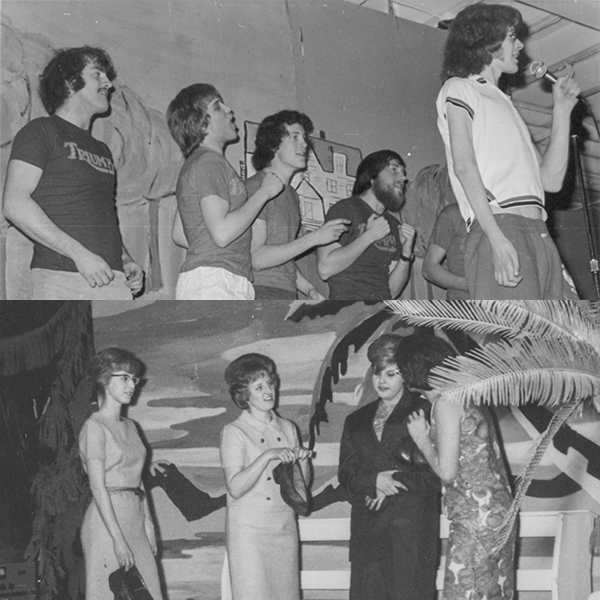
It's Party Time
THE GIRLS' PARTY FOR THE BOYS and the Boys’ Party for the Girls were Camrose Lutheran College and Augustana University College traditions that trace to the 1930s or earlier. The guys and girls would plan an afternoon or evening of extravagant entertainment, food and frivolity for the opposite sex — preferably about which all details were kept secret until the party started. Girls were known to plan the menu and even help cafeteria staff cook the boys’ meals. (Whether the boys did the same is lost to history.) But the spirit of giving was not without the spirit of one-upmanship. Themes ranged from Joyeux Paris to Poseidon Under the Sea, with each party more extravagant than the last. In the late 1970s, the boys built a Viking ship in the gymnasium, complete with a telephone-pole mast, sail and wooden frame made from borrowed timber. The parties carried on into the 1990s before becoming memories of a bygone era. Share your favourite party stories with us at augalum@ualberta.ca –LISA SZABO, ’16 BA
